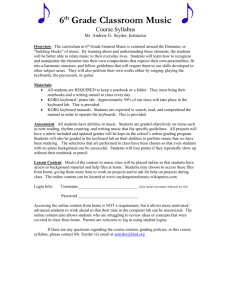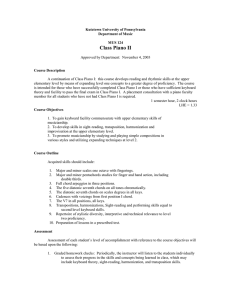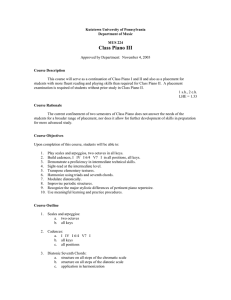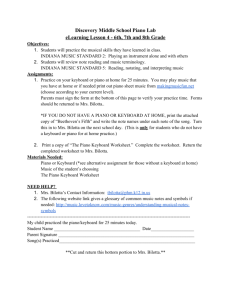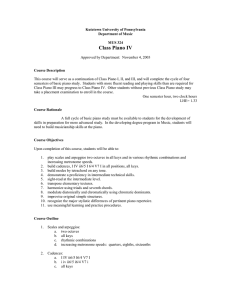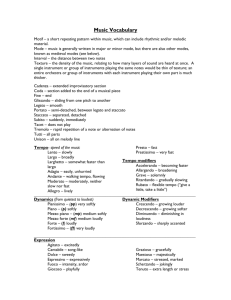Class Piano I
advertisement
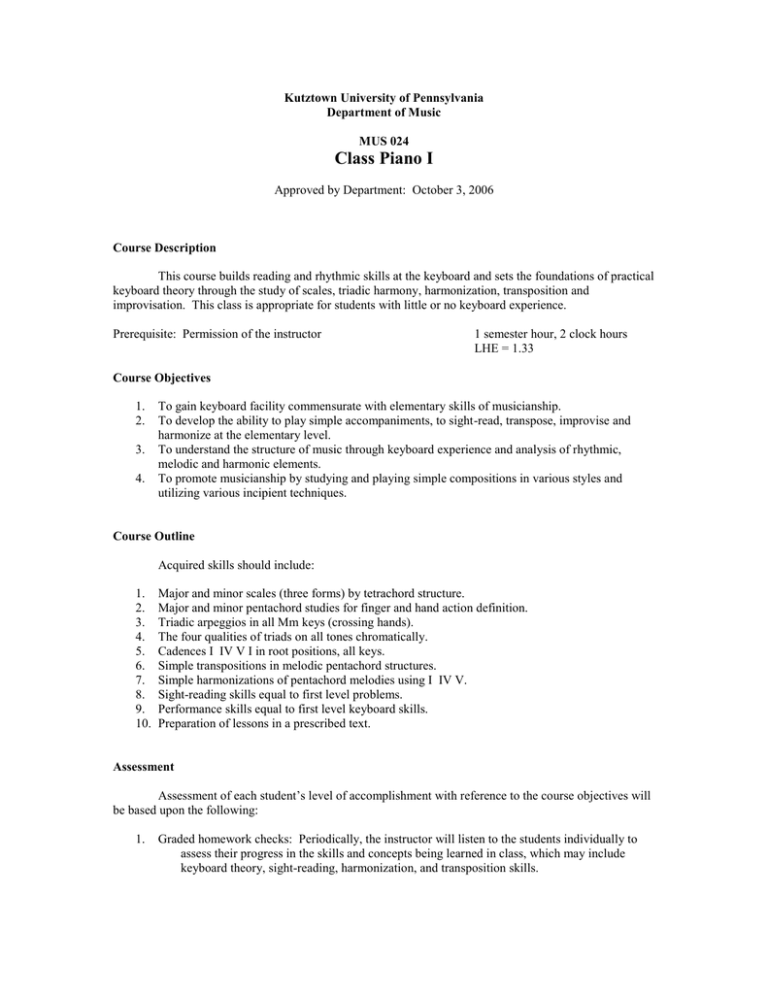
Kutztown University of Pennsylvania Department of Music MUS 024 Class Piano I Approved by Department: October 3, 2006 Course Description This course builds reading and rhythmic skills at the keyboard and sets the foundations of practical keyboard theory through the study of scales, triadic harmony, harmonization, transposition and improvisation. This class is appropriate for students with little or no keyboard experience. Prerequisite: Permission of the instructor 1 semester hour, 2 clock hours LHE = 1.33 Course Objectives 1. 2. 3. 4. To gain keyboard facility commensurate with elementary skills of musicianship. To develop the ability to play simple accompaniments, to sight-read, transpose, improvise and harmonize at the elementary level. To understand the structure of music through keyboard experience and analysis of rhythmic, melodic and harmonic elements. To promote musicianship by studying and playing simple compositions in various styles and utilizing various incipient techniques. Course Outline Acquired skills should include: 1. 2. 3. 4. 5. 6. 7. 8. 9. 10. Major and minor scales (three forms) by tetrachord structure. Major and minor pentachord studies for finger and hand action definition. Triadic arpeggios in all Mm keys (crossing hands). The four qualities of triads on all tones chromatically. Cadences I IV V I in root positions, all keys. Simple transpositions in melodic pentachord structures. Simple harmonizations of pentachord melodies using I IV V. Sight-reading skills equal to first level problems. Performance skills equal to first level keyboard skills. Preparation of lessons in a prescribed text. Assessment Assessment of each student’s level of accomplishment with reference to the course objectives will be based upon the following: 1. Graded homework checks: Periodically, the instructor will listen to the students individually to assess their progress in the skills and concepts being learned in class, which may include keyboard theory, sight-reading, harmonization, and transposition skills. 2. 3. 4. Class participation: Student attendance and quality of class participation are essential in developing new skills, and will therefore be recorded. Through the listening console in the piano lab, the instructor is also able to listen to any number of students and will have the chance to evaluate their progress and participation. Prepared Performances: At least once during the semester, the student will perform music he or she has learned, in class. Final Exam: The student will demonstrate the degree to which they have developed the required skills by performing for the instructor. Skills are in the area of keyboard theory, sightreading, harmonization, and transposition. Instructional Resources Burmeister, Ellen. Keyboard Sight-Reading. Mountain View, California: Mayfield Publishing Company, 1991. Giles, Allen. Beginning Piano an Adult Approach. Philadelphia, Pennsylvania: Theodore Presser Company, 1978. Hackett, Patricia. The Melody Book. Second Edition. Englewood Cliffs, New Jersey: Prentice Hall, 1992. Lancaster, E. L. and Kenon D. Renfrow. Alfred’s Group Piano for Adults: an Innovative Method with Optional Compact Discs and General MIDI Disks for Enhanced Practice and Performance. Van Nuys, California: Alfred Publishing Co., Inc. 1995. Lindeman, Carolynn A. Piano Lab: An Introduction to Class Piano. Belmont, California: Wadsworth Publishing Company, 1995. Lyke, James, et. al. Keyboard Musicianship, Book Two. Seventh Edition. Champaign, Illinois: Stipes Publishing Company, Fifth Edition, 1999. Mach, Elyse. Contemporary Class Piano. Sixth Edition. New York: Oxford University Press, 2004. Olson, Lynn Freeman. Piano for Pleasure. New York: West Publishing Company, 1986. Pederson, Gale. Key to the Keys. Guilford, CT: Audio-Forum, 1995. Robison, Helene. Basic Piano for Adults. Belmont, California: Wadsworth Publishing Company, 1964. Spillman, Robert. Sight-Reading at the Keyboard. New York: Schirmer Books, 1990. Starr, William and Constance Starr. Practical Piano Skills. Dubuque, Iowa: Wm. C. Brown Publishers (3rd Edition), 1984.
